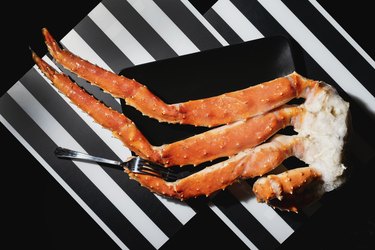
Cooking frozen crab legs in the oven is a great way to have a healthy quick meal on the nights you don't feel like making much effort. You can do it with or without an oven bag, and quick thawing is easy.
What Are Crab Legs?
Video of the Day
Crab legs are a healthy and delicious seafood treat. Most commonly, you'll either be dealing with king crab legs or snow crab legs. Unlike other crab dishes, you're eating just the legs, not the claws or main body.
Video of the Day
The National Oceanic and Atmospheric Administration (NOAA) says red king crab is one of the smartest seafood choices because wild-caught red king crab is sustainably managed and responsibly harvested. You may also hear this species called Alaskan king crab because that's where it is native. Snow crab, according to the NOAA, is also a smart seafood choice because it too is sustainably managed and responsibly harvested.
According to the Environmental Defense Fund, red king crab, blue king crab, snow crab and stone crab that come from the U.S. all have "best" eco-ratings and low mercury levels, making them great choices for seafood to include in your regular diet. Crab from imported sources is the worst choice in terms of eco-rating.
Read more: Fish with Low Potassium Levels
Cooking Crab Legs in Oven Bags
If you want to cook frozen crab legs in the oven seafood boil style, put your crab legs in an oven bag. If the crab legs are frozen, run them under cold water to quick thaw them until they are pliable but still icy. Preheat the oven to 400 degrees Fahrenheit.
Add the other ingredients, such as corn cobs, sausage, potatoes and seasonings. Add butter and lemon juice to the bag. Tie the bag at the top and shake it. Place inside another oven bag and tie it.
Bake for 45 minutes. Carefully cut open the bag to avoid steam burn. According to the U.S. Food and Drug Administration, the crab legs are done when they have reached an internal temperature of 145 F. You'll need to break one open and check that the meat inside is firm, white and flakes easily to be sure they are done.
If you don't want to cook your crab legs in an oven bag, you can preheat your oven to 350 F and fill a baking dish with a bit of hot water. You can bake from frozen if you allow for a bit more cooking time.
Add the crab legs to the pan with your desired seasonings. Arrange the crabs in a single layer. Cover the pan with aluminum foil.
Bake for seven to 10 minutes total, turning the crabs at around the four-minute mark. This ensures even cooking. Put the aluminum foil back in place after turning. Once the crab legs have finished cooking, remove from pan and serve warm.
Read more: 4 Disadvantages of a Pescatarian Diet
Health Benefits of Crab Legs
Cooking frozen crab legs in the oven is one of the healthiest methods because it does not add any fat. Crabs are high in protein and naturally low in fat. Fried seafood options add fat and carbohydrates, which often negates much of their health benefits.
According to the U.S. Department of Agriculture (USDA), a 3-ounce serving of king crab legs contains 80 calories and 16 grams of protein, with just 1.5 grams of fat. Watch for added salt in any branded products, as USDA data shows 910 milligrams per serving.
The USDA shows that snow crabs have a similar nutritional profile with 70 calories, 15 grams of protein and half a gram of fat. The branded data indicates 650 milligrams of sodium per serving.
The American Heart Association recommends eating no more than 2,300 milligrams of sodium per day, so it's a good idea to watch sodium intake from other foods on days you eat crab legs, especially if you eat large portions.
A July 2012 study in Food Chemistry looked at whether boiling or steaming changed the nutritional value of crab. While the study showed it does not, it is worth noting the white meat, like that found in crab legs, is much healthier than the brown meat that's found in other areas of the body.
- National Oceanic and Atmospheric Administration: "Alaska Snow Crab"
- National Oceanic and Atmospheric Administration: "Snow King Crab"
- Environmental Defense Fund: "EDF Seafood Selector: Crab"
- U.S. Food and Drug Administration: "Selecting and Serving Fresh and Frozen Seafood Safely"
- U.S. Department of Agriculture: "King Crab Legs"
- U.S. Department of Agriculture: "Snow Crab Legs"
- American Heart Association: "How Much Sodium Should I Eat Per Day?"
- Food Chemistry: "Nutritional Quality and Safety of Cooked Edible Crab"